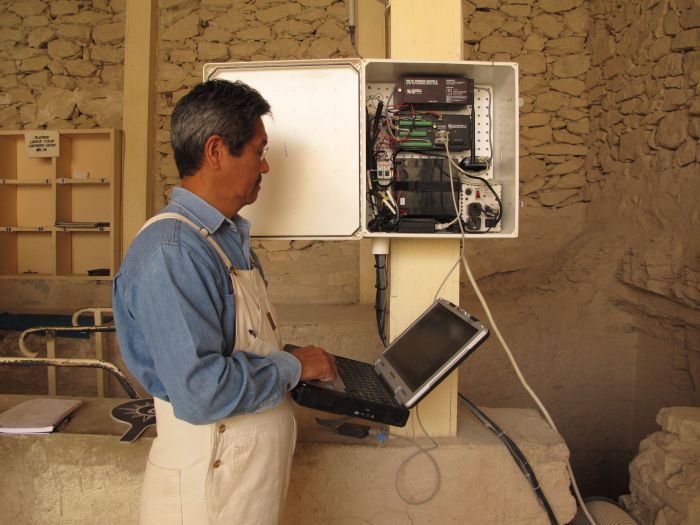






In 1922, when the intact tomb of Tutankhamen was discovered in Egypt's Valley of the Kings, the tomb was full of treasures, artwork, and other artifacts. In most other tombs that archaeologists discovered, these items had been stolen or vandalized before preservation specialists could protect them. While most of the contents of King Tut’s tomb were relocated to museums in Cairo, the mummy, quartzite sarcophagus and its granite lid, and wall paintings remain onsite for the enjoyment of visitors. The tomb is now one of the most visited sites in the Valley of the Kings.
The tomb walls are covered with priceless murals depicting scenes of Tutankhamen’s journey into the afterlife, but as time has passed, the paintings have begun to deteriorate. In 2009, Egypt's Supreme Council of Antiquities (now named the Ministry of Tourism and Antiquities [Egypt]) and the Getty Conservation Institute collaborated on a multi-phase plan to evaluate and manage the effects of visitors on the condition of the tomb. Key issues were to understand the conditions of the tomb, the negative impact of daily visitation, and the environmental risks to the murals and other remaining artifacts. The project’s plan was to collect and analyze data from sensors inside the tomb and from a meteorological station outside the tomb.
Initially, a battery-powered automated weather station was installed near the entrance to the tomb to monitor the general site climate, including air temperature, relative humidity, solar radiation, wind speed and direction, and rainfall. Inside the tomb, sensors were installed to monitor microclimatic conditions, such as interior air temperature, relative humidity, dew point temperature, and carbon dioxide level.
To enable frequent data analysis, a cellular modem was used with a data logger to transmit the data to the Los Angeles office of the Getty Conservation Institute—the project’s headquarters. The data was then posted automatically on the project’s website.
Analysis of the data indicated that the lack of air movement into and out of the tomb was contributing to high levels of relative humidity. Frequent visitors to the tomb also contributed to an unstable microclimate with high carbon dioxide levels and rapid fluctuations in both interior air temperature and relative humidity. In addition, constant visitation to this popular site (foot traffic) and wind promoted the entry of fine airborne particulates (dust) into the tomb. These factors, in turn, contributed to the deterioration of the wall paintings and other artifacts. In 2013, after the initial data-acquisition phase of the project was completed, the original system was dismantled.
During the next phase of the project, members of the Getty Conservation Institute and the Ministry of Tourism and Antiquities (Egypt) analyzed the data to design strategies for the management of visitor and environmental impacts for the conservation of this historic site. Efforts to stabilize the environmental conditions at the tomb and reduce the amount of dust included implementing a filtered-air supply and exhaust ventilation system, as well as infrastructure improvements.
In 2016, after the ventilation system with filtered-air supply was installed, the second monitoring phase was started to help ensure the preservation of the paintings and other artifacts, as well as the efficacy of the applied conservation measures. The selected monitoring equipment from Campbell Scientific needed to be robust to perform well in a dusty environment. Moreover, it had to be low maintenance in terms of requiring minimal specialized knowledge and using tools and replacement parts that could be easily obtained locally.
A new automated weather station monitors the weather conditions outside the tomb’s entrance. Sensors inside the tomb monitor the microclimate, particularly the air temperature and relative humidity. This data is used to control the air ventilation system and generate email alarms to stakeholders based on environmental conditions.
Implementing a filtered-air supply and exhaust ventilation system—and closely monitoring the environmental data—has improved the conditions within the tomb. In turn, this has helped preservation specialists maintain the tomb’s paintings and other artifacts for the enjoyment of visitors year-round.
While the project with the Getty Conservation Institute officially ended in 2019, the local conservation staff members still perform seasonal data analysis to assess the effectiveness of the visitor-management strategies on the tomb’s microclimate and the overall condition of the tomb’s artifacts. This analysis helps ensure the sustainability of the conservation measures and that the legacy of Tutankhamen’s tomb is protected and preserved for future generations.
Sumário de Estudos de Caso
Aplicação
Monitoring environmental conditions at historical siteLocalização
Valley of the Kings, EgyptProdutos Utilizados
RAVENXTG TE525MM-L CS11-L PS150 HMP45C-L 05103-L LI200X-L SP10 CR1000Colaboradores
Shin Maekawa and Vincent Beltran, Getty Conservation InstituteOrganizações Participantes
Ministry of Tourism and Antiquities (Egypt)Parâmetros de Medição
Air temperature, relative humidity, solar radiation, wind speed and direction, rainfall, carbon dioxide, dew point temperatureWebsites Relacionados
Conservation and Management of the Tomb of Tutankhamen (2009–2019)Consultor/Integrador Participante
Helio ScientificVer o PDF